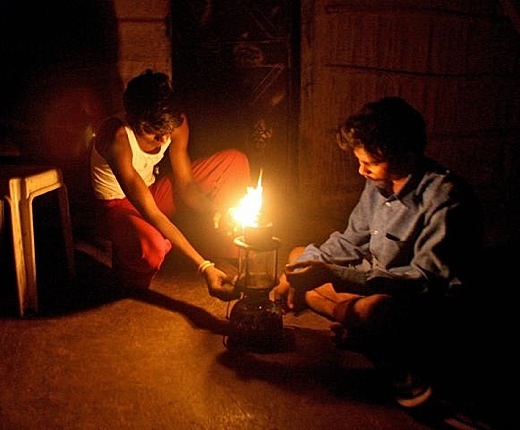SUBHEAD: Not only is kerosene more expensive, but solar is affordable and getting more popular in 3rd World.
By Sami Grover on 26 August 2011 for TreeHugger -
(http://www.treehugger.com/files/2011/08/solar-cheaper-kerosene.php)

Image above: Villagers in Wada, India, light kerosene lamp. From (http://www.theepochtimes.com/n2/content/view/24539).
We know that solar can be a lifesaver in rural Africa, replacing dirty, polluting and potentially dangerous kerosene lamps. We've also seen how solar lanterns can create economic opportunities for micro-entrepreneurship. Still, it's good to read a blog post by Yotam Ariel over at Renewale Energy World on how solar is becoming cheaper than kerosene lamps for many off-grid poor communities. It's particularly encouraging to see that the boom in solar products is being driven not just by charitable purchases anymore, but by communities themselves as they recognize the superior performance and economic benefits of clean energy:
See also:
Ea O Ka Aina: China says PV to beat Coal 8/19/11
.
By Sami Grover on 26 August 2011 for TreeHugger -
(http://www.treehugger.com/files/2011/08/solar-cheaper-kerosene.php)

Image above: Villagers in Wada, India, light kerosene lamp. From (http://www.theepochtimes.com/n2/content/view/24539).
We know that solar can be a lifesaver in rural Africa, replacing dirty, polluting and potentially dangerous kerosene lamps. We've also seen how solar lanterns can create economic opportunities for micro-entrepreneurship. Still, it's good to read a blog post by Yotam Ariel over at Renewale Energy World on how solar is becoming cheaper than kerosene lamps for many off-grid poor communities. It's particularly encouraging to see that the boom in solar products is being driven not just by charitable purchases anymore, but by communities themselves as they recognize the superior performance and economic benefits of clean energy:
Unlike the past decade, which saw solar solutions purchased mainly by international donors, it is now the locals who are increasingly opening their wallets to make the switch from their traditional energy means. That is because solar products prices in recent years have declined to become cheaper than kerosene and batteries.
Barriers remain, including distribution, access to up-front capital, and gender inequality issues. But the future is looking decidedly sunny for solar in the Global South.
In Cambodia, for example, villagers can buy a solar lantern at US$25 and use it for two years without any extra costs, where their previous spending on kerosene for lighting was about $2.5 per month, or $30 per year. In Kenya a solar kit that provides bright light or powers a radio or cell phone costs under $30 at retail stores. By switching to this kit Kenyans can save $120 per year on kerosene lighting, radio batteries and cell phone recharging fees.
See also:
Ea O Ka Aina: China says PV to beat Coal 8/19/11
.
No comments :
Post a Comment